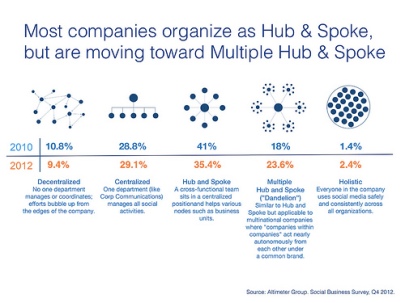
The Altimeter Group’s report from earlier this year, The Evolution of Social Business: Six Stages of Social Business Transformation, offers the above graphic to exemplify the way social networking develops as the social activities of businesses mature. I tend to feel skeptical about many developmental models in social business simply because markets differ, sometimes in fundamental ways, and businesses organize accordingly. However, since a previous post here summarized the currently dominant Hub and Spoke approach as falling short as a way to organize collaboration in relation to customer experience, I feel elaborating on that point is in order.
Shared experience, not just shared information, is fundamental to the social networks underlying collaboration and innovation. Many, if not most, employees don’t only need to get to know one another through reputation systems, like who people tag as possessing expertise. As Thomas Vander Wal continues to point out, comfort with one another is needed to develop a shared experience that encourages the open sharing of information.
Collaboration means getting to know that other employees possess expertise on this or that topic, but also developing comfort with one another by sharing significant symbols relating to self, family, friends, and social activities, thereby understanding one another as people. Shared experience with co-workers and customers is a key factor in innovative business practices. It is especially important to multichannel collaboration.
Shared experience is so important because, as Karl Weick so deftly noted almost twenty years ago, it provides the basis for mutual understanding or, to put it bluntly, how we understand one another when we do things together. Nancy Dixon recently offered a concise summary of this point which I recommend reading.
I’ve noted the importance of shared experience to collaboration in several posts. Michael Sampson summarized the points I’ve tried to make as aptly as anyone in his post Get to Know Your Virtual Colleagues as People – and Good Things Happen (to Important Things Like Productivity) and his perspective is much appreciated by me. He noted:
Trust between collaborators is an important factor related to collaboration effectiveness. Spending time talking to and learning about the people you work with provides the mechanism for trust to flourish – if they are trustworthy – or diminish – if they are not worthy of your trust…It makes sense that when people experience the same thing together – creating shared history and shared memories – it binds the group together in a much deeper way than merely having the same information.
So, you might say, what does this have to do with organizational silos?
The best way to begin answering the question is to look at an interesting insight offered by Mark Fidelman and Dion Hinchliffe regarding the cross-currents enterprises face in attempts to use social software to increase collaboration. In Rethinking the Customer Journey in a Social World they noted:
…it’s the mindset of the social world, where everyone knows what everyone else is doing, and perhaps even thinking, that may very well be the hardest to adapt to and instill in our corporate culture. It’s a world where those who know how to tap into global knowledge flows in social networks on the “edge” of our businesses will succeed. Thus, we need a new vocabulary for understanding not only our businesses, but how it will deeply affect the entire experience of our customers, from beginning to end. This transformation of thinking and working is required in order to access the significant benefits of truly remaking how we engage with the market.
Their thinking seems torn between insight into where the changes for business are headed and what they think likely to happen in the short-term. Dion in particular recognizes the fact that social business requires organizational transformation when, for instance, he asserts, ” social business is first and foremost a transformation involving people and the organizations they work with.” Yet, if you consider where he thinks the in-roads for social software (including social media) are for business over the next year or so, the contrast in perspective is pretty distinct. Dion says in another post that it is in the vertical space of enterprises where most of the innovation is set to occur for social software.
While general purpose social software platforms can certainly be used in all of these areas, high impact application of social media to the way we work often requires application-specific constraints on conversations and the resultant community activity (my emphasis). This means social customer care benefits from conversations organized around support, social supply chain focused on ERP transactions, and so on, along with software that supports these applied uses.
Yammer spread out over Sharepoint sites is a good example. The enterprise use-cases of social business implementation offered by Ray Wang support Dion’s assertion. Indeed, one of the recent findings by The Community Roundtable offered in their 2013 State of Community Management report is indicative. The report observes that community managers are most often “hubs” and, further, that:
Key factors, such as the amount of cross-functional interactions and size of community teams [with external or internal focus — my point], are putting a resource strain on community managers, particularly in large organizations.
A key organizational point is worth making here because it relates directly to the burdens the hub-and-spoke model, whether cross-functional or dandelion, places on collaboration between employees, customers, partners, and other stakeholders. Indeed, the “Tip” offered by Jeremiah Owyang of Altimeter regarding the “dandelion” hub-and spoke model is telling. He noted that,
the lines connecting the multiple hubs may be severed. Tip: provide way for spokes to connect to each other, not just be funneled through a central group.
Just like social networks do not respect organizational boundaries, edge cases do not respect vertical (read, silo-oriented) organizational constraints on conversation. This is an important point when you consider that most of the time spent by employees involves dealing with edge cases, i.e. exceptions to core processes. I suggest that at least part of this outcome results from the fact that not enough employees in the enterprise develop shared experiences. If you agree with me, I guess we just need to think about how to make this happen. If not, then you probably need a bit more detail which, hopefully, you can spare the time for.



 Posted by Larry Irons
Posted by Larry Irons 


 As a
As a 
